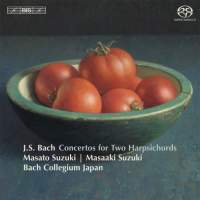Texte paru dans: / Appeared in:
*

International Record Review - (07-08//2014)
Pour
s'abonner / Subscription information
BIS
BISSA2051

Code-barres / Barcode : 7318599920511
(ID450)
Consultez toutes les évaluations recensées pour ce cd
~~~~ Reach all the evaluations located for this CD
As Yo Tomita points out in his booklet note, Bach spent much more time performing orchestral pieces with the Collegium , Musicum in Leipzig, of which he became the director in 1729, than he did cantatas as Thomascantor. The Collegium met for two hours every week ‑ 4‑6 p.m. on Wednesdays during summertime at Gottfried Zimmermann's coffee garden (outside the East gate of the city), and 8‑10 p.m. every Friday in winter at Zimmermann's coffee house in the town centre. Evidently there was great popular demand to experience Bach, the great keyboard virtuoso, in concert with illustrious colleagues. Frustratingly little detail about the group's activities ‑ such as exactly which works were performed when, or how much time, if any, they spent rehearsing ‑ is known, but the surviving body of harpsichord concertos which Bach wrote or, more often, adapted from earlier works, for the Collegium is extensive.
Masaaki Suzuki was little known outside his native Japan when he embarked on his recently completed cycle of Bach's sacred cantatas with his Bach Collegium Japan for BIS nearly 20 years ago ‑ but, with this monumental achievement under his belt, his international stature as a master Bach interpreter is now indisputable. His latest disc is a chance for him to shine as harpsichord soloist in the three surviving concertos for two harpsichords, which all date from around 1736. BWV1060, in C minor, is thought to be an arrangement of Bach's earlier concerto for violin and oboe; the ebullient BWV1061, in C, was probably written initially for harpsichord duo, the string accompaniment added later; BWVt062, in C minor, is an arrangement of Bach's famous Double Violin Concerto in D minor.
Suzuki adopts a one‑to‑a‑part approach to the orchestra (it seems probable that this was how Bach usually performed at the coffee houses) ‑ two violins, viola, cello and bass violone. Bolstered by the two harpsichords, the overall sound is satisfyingly full in the tuttis, but the group can also achieve an effective chamber intimacy at times. Outer movements bristle with energy, vibrancy and joyfulness, slow movements flow sensitively, always attuned to the dance rhythms at the heart of so much of Bach's music.
Bach's sons often joined him in his coffee house performances, so it is fitting that Suzuki's own son Masato, a regular participator in the Japan Collegium's recordings, is the second soloist. They swap between the first and second parts (not that there is any difference between them in terms of technical demands), playing on Willem Kroesbergen copies of two‑manual instruments by Couchet and Ruckers. Thanks to BIS's excellent recording, the harpsichords are clearly delineated with realistic spatial separation, and even the different tonal quality of each instrument comes across distinctly. This is a major point in the album's favour. The harpsichords of Trevor Pinnock and Kenneth Gilbert in Pinnock's benchmark set with The English Concert sound comparatively generic and brittle in their 1980 recording for Archiv. The Japanese players win too in terms of apparent spontaneity, with generally brisker tempos than Pinnock and company, who often seem studied, sometimes even plodding, in direct comparison. Yet the pay‑off for Pinnock is clarity. Melodic lines can often get lost in the mêlée in these harpsichord arrangements of concertos originally written for sustaining solo instruments, a hazard which Pinnock measured approach overcomes more successfully than Suzuki. So, on balance, fans of these works will probably want to own both sets ‑ both have great merits and slight drawbacks. Certainly this new album is thoroughly enjoyable.
As
a bonus, Suzuki junior offers his own arrangement for two harpsichords
(without orchestra) of Bach's Orchestral Suite No. 1. There is no historical
grounds for this (other than the fact that Bach is known often to have
arranged his own music, and would presumably have had to supply new music
regularly for performance with the Collegium Musicum) but that doesn't
matter ‑ Masato has done an impressive job, and he and his father offer a
persuasive performance that conveys the grandiosity, geniality and
virtuosity of this substantial work's many flavoured dance movements with
infectious delight.
Fermer la fenêtre/Close window
Cliquez l'un ou l'autre
bouton pour découvrir bien d'autres critiques de CD
Click either button for many other reviews


